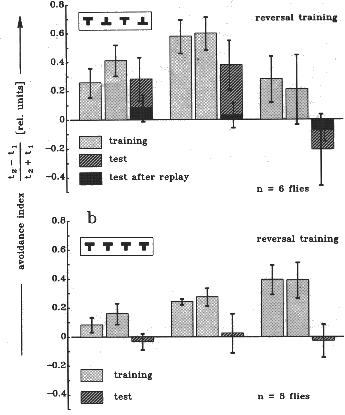Visual Pattern Discrimination Learning
(flight direction can operate a heat source)
As described when explaining the Drosophila flight simulator, in this paradigm the rotational speed of the arena is made proportional to the fly's recorded yaw torque around its vertical body axis. This enables the fly to stabilize the rotational movements of the panorama (i.e. to fly straight) and to adjust certain flight directions with respect to particular visual landmarks. Usually, the landmarks are 4 patterns of alternating shapes evenly spaced at the periphery of the arena. Whenever one of the two pattern types is in the frontal position, the fly is punished by an infrared lightbeam, focussed onto its abdomen. Drosophila quickly learns to avoid the heat and stabilize the arena with the 'cold' pattern in the frontal position, with short excursions into the heated sectors. The perfomance increases during the training period, suggesting that some learning occurs during the flight. If the heat is permanently switched off, the flies keep their pattern preference towards the previously 'cold' pattern for at least several minutes.
Flies are unable to develop a pattern preference if they fly in 'open loop' and the movements of the arena (together with the heating schedule), recorded from a previously trained fly, are played back to them. However, Drosophila can be trained classically as described when explaining the Drosophila flight simulator. Thus, in this paradigm, it is not solely the sequence of patterns associated with heat that determine learning performance, but some operant component is required as well.

Pattern avoidance learning is an operant process. The flight simulator establishes normal negative feedback between angular velocity and yaw torque. Instead of a single stripe the panorama consists of 4 equally spaced patterns as shown when describing the Drosophila flight simulator. Flies are trained to avoid every second pattern by being heated with the IR beam whenever the respective pattern is in the frontal quadrant of the visual field (pattern width (max.) d = 40°; height (max.) theta = +- 20°). Each experiment lasts 9 x 2 min. After 2 x 2 min of training (light shaded bars) a test period (hatched bars) without heat is introduced; this whole sequence is repeated once; during the last three 2-min intervals the fly is trained twice for 2 min to avoid the alternative patterns and is subsequently tested. In (a) all training periods are digitally recorded and one day later flies are subjected to the identical sequence of pattern motion and heating as during the original experiment. The subsequent test shows that in this passive manner flies do not learn to avoid the heat-associated patterns (black bars). Controls ruling out fatigue not shown. In (b) the patterns are distinguished only by their position in the arena which is not a cue for associative learning in this paradigm. The avoidance index is defined as (t2-t1)/(t2+t1) with t2 being the time during which the patterns not associated with heat were kept in the frontal quadrant of the visual field. Error bars are SEMs.